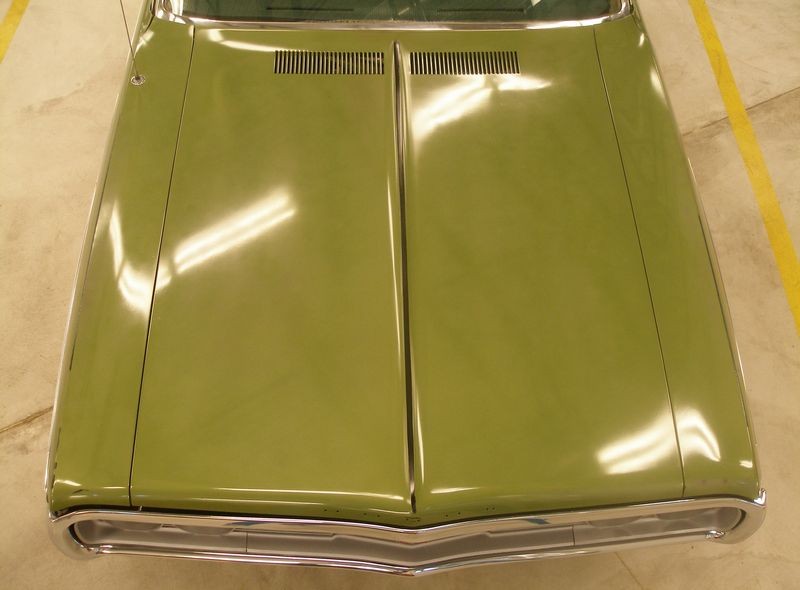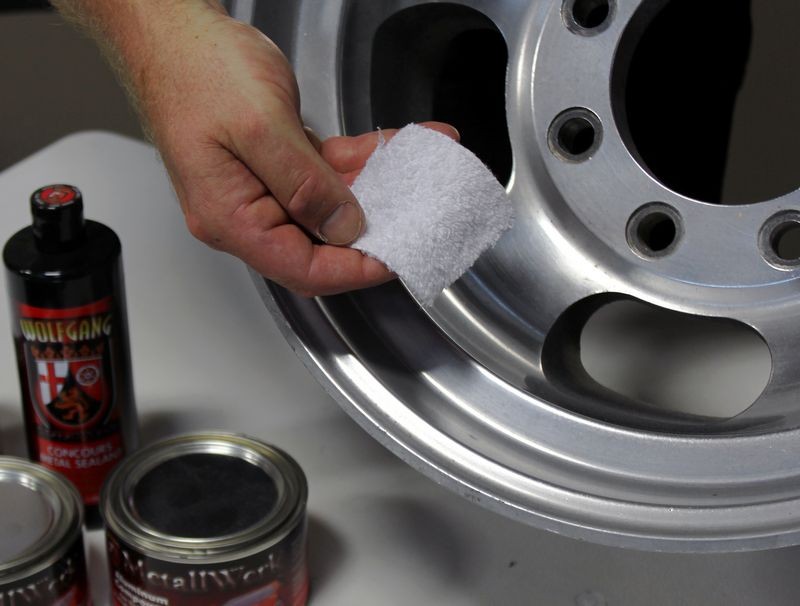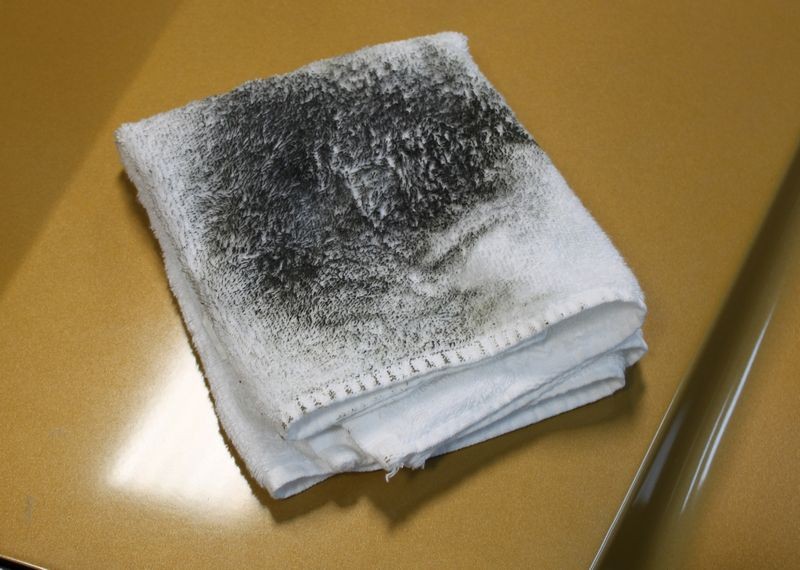Mike Phillips
Active member
- Dec 5, 2022
- 51,004
- 6
Single Stage Metallic & Clearcoat Metallic --> Same Car
It's not very often you find a car painted with two very different types of paint but we ran into this when we buffed out the 1938 Plymouth Streetrod shown in this thread,
1938 Plymouth Sedan Streetrod Extreme Makeover!
Frank and Pauline were buffing out the massive trunk lid on the back of the car and Frank came over and showed me the pads on the right and how no matter how much they buffed they kept pulling a black color from the paint?


On the left is the Yellow Cyclo Foam Cutting Pads and Pinnacle Advanced Swirl Remover which is a medium cut polish that is also white in color.
To the right side are the same yellow pads with the same polish only now the pads have turned black!



Over all of the rest of the car the no black color came off onto our pads.
What's going on?
Here's what's going on... the trunk lid on this streetrod is painted using a single stage metallic paint system and the black coming off is the oxidation that has taken place to the aluminum flake used in the paint.
I explain how this happens in my article on how to restore antique single stage paint here,
The Secret to Removing Oxidation and Restoring a Show Car Finish to Antique Single Stage Paints
Here's an excerpt...
I used an aluminum wheel to help explain how this works in this article,
The Secret to Removing Oxidation and Restoring a Show Car Finish to Antique Single Stage Paints
Note the color of the residue on the white terry cloth towel even though the color of the paint is butterscotch...
One thing that anyone buffing out a single stage metallic finish has to be very careful about is not to induce Tiger Stripes into the paint.
Tiger Stripes is where you have buffed too much and thus remove too much paint and flake and you can actually see what looks like stripes in the paint in the direction you've moved the buffer. Once you do this there's no way to undo the damage and buffing more and more will only make the problem worse and worse.
With single stage metallic paints, you can only remove so much material.
So be careful anytime you buff on older, single stage metallic paints.
>>>>> End of excerpt<<<<<<
Caution! Tiger Stripes
There's no way to stop the oxidation from happening outside of regular polishing and waxing to keep the surface clean.
You cannot simply buff and buff and buff in an effort to get out all the oxidation. It's not going to happen and if you buff too much you'll change the appearance of the paint and cause what are called Tiger Stripes.
Tiger Stripes during the painting process
Tiger Stripes can mean two things in the car paint world, in one example Tiger Stripes can mean the stripes or line appearance in the paint due to how the painter sprayed the paint leaving what looks like lines in the paint.
Tiger Stripes
Tiger Stripes

Tiger Stripes from the buffing process
For this meaning of the term tiger stripes, if you buff too much on single stage metallic paint you will remove enough pigmented or colored paint plus abraded the aluminum flakes enough to leave stripes or lines in the paint that mimic the way you moved the buffer over the paint.
I don't have any good pictures of Tiger Stripes from over-buffing single stage metallic paint. I've seen it in my life but must not have had a camera handy.
You can get an idea of what this over buffing of single stage paint can look like in this write-up. I'm not saying my friend Craig over buffed this paint, it could have happened from before he owned the car. But you can definitely see a pattern of light and dark lines in the paint after he removed the extreme oxidation and restored clarity and gloss to the finish.
1971 Dodge Coronet Original Paint Extreme Makeover with Meguiar's #7 Show Car Glaze
Before


After


What can you do?
The best thing you can do when buffing on single stage metallic paint is to take a very non-aggressive approach when choosing compounds and polishes and use a light touch. Then always use a crosshatch pattern when buffing, don't simply go from side to side.
And if it's not your car then less is more...
First educate your customer on the type of paint their car has and the unique issues buffing on and restoring this type of paint brings to the table. Then under promise what you can do and then do your best to over deliver. And of course this forum is always here to help.

It's not very often you find a car painted with two very different types of paint but we ran into this when we buffed out the 1938 Plymouth Streetrod shown in this thread,
1938 Plymouth Sedan Streetrod Extreme Makeover!
Frank and Pauline were buffing out the massive trunk lid on the back of the car and Frank came over and showed me the pads on the right and how no matter how much they buffed they kept pulling a black color from the paint?
On the left is the Yellow Cyclo Foam Cutting Pads and Pinnacle Advanced Swirl Remover which is a medium cut polish that is also white in color.
To the right side are the same yellow pads with the same polish only now the pads have turned black!
Over all of the rest of the car the no black color came off onto our pads.
What's going on?
Here's what's going on... the trunk lid on this streetrod is painted using a single stage metallic paint system and the black coming off is the oxidation that has taken place to the aluminum flake used in the paint.
I explain how this happens in my article on how to restore antique single stage paint here,
The Secret to Removing Oxidation and Restoring a Show Car Finish to Antique Single Stage Paints
Here's an excerpt...
I used an aluminum wheel to help explain how this works in this article,
The Secret to Removing Oxidation and Restoring a Show Car Finish to Antique Single Stage Paints
Mike Phillips said:Single Stage Metallic Paint = Difficult to Restore
Single stage, non-metallic paints like the above paint on the Ranchero are actually very easy to fix because the problem is for the most part just topical, that is the problem is just on the surface. All you have to do is remove the dead paint off the surface and if there's enough paint left then it's just a matter of polishing what's left to a high gloss. The most difficult paints to restore are single stage metallic paints.
The reason single stage metallic paints are the most difficult to restore is because not only does the paint itself oxidize, that is the resin used as the binder, (generally some type of seed oil like Flaxseed oil or Cottonseed oil), but also the aluminum flakes embodied inside the paint oxidize. This is where the problem lies.
It's a problem because the entire exterior surface of each individual aluminum flake oxidizes over time but you and I can only work on the surface of the paint and thus we can only work on the portion of the flake that is exposed at the surface level. Any portion of each aluminum flake that is below the surface and is surrounded by paint cannot be cleaned or polished so there's no way to remove the oxidation on the portions of the flakes inside the paint.
Oxidized Aluminum Turns Black
With metallic single stage paints, oxidation can show up as a darkening effect on medium to light colored paints because the aluminum metal flakes embodied inside the paint will stain or discolor the paint with a grayish black color.
If you’ve ever polished uncoated aluminum then you’ve seen this grayish black color coming off the aluminum and onto your polishing cloth as you work a metal polish over it. This same type of oxidation is taking place to the aluminum flake inside the paint.
Polishing Uncoated Aluminum


Oxidized Aluminum Comes Off Black

Wolfgang MetallWerk™ Aluminum Polishing System
In the same way you see the black residue coming off the aluminum wheel onto the piece of white cotton terry cloth material above, when working on metallic single stage paints you will see black residue coming off the paint and onto you applicator pads, buffing pads and wiping towels.
This darkening effect can take place even at the same time the surface of the paint itself is turning chalky white. This is because you have two different substances oxidizing, both the paint and the aluminum flake, which both are oxidizing at the same time. The paint oxidizes white and the aluminum flake oxidizes black.
Note the color of the residue on the white terry cloth towel even though the color of the paint is butterscotch...
Mike Phillips said:After approximately 12 hours of soaking in #7 Show Car Glaze, we're ready to wipe off the first application off this 37-year old paint.

Look at the paint surrounding the towel...
In the picture below, note how after just one well-worked application of #7 the finish is now more smooth and clear and the color is more vibrant and even.

Look at the color of the residue coming off the paint and onto the white terry cloth towel; it's black. The single stage paint is butterscotch gold.
Question: Where's the blackness coming from?
Answer: The aluminum flake.
One of the benefits that we enjoy when car manufacturers switched over to basecoat/clearcoat paint technology is there's a clear layer of paint covering over the color coat of paint and this seals the paint and keeps it from oxidizing and deteriorating. This enables metallic finishes to last for a long time without oxidizing and this is why you no longer see any black residue coming off modern metallic finishes.
One thing that anyone buffing out a single stage metallic finish has to be very careful about is not to induce Tiger Stripes into the paint.
Tiger Stripes is where you have buffed too much and thus remove too much paint and flake and you can actually see what looks like stripes in the paint in the direction you've moved the buffer. Once you do this there's no way to undo the damage and buffing more and more will only make the problem worse and worse.
With single stage metallic paints, you can only remove so much material.
So be careful anytime you buff on older, single stage metallic paints.
>>>>> End of excerpt<<<<<<
Caution! Tiger Stripes
There's no way to stop the oxidation from happening outside of regular polishing and waxing to keep the surface clean.
You cannot simply buff and buff and buff in an effort to get out all the oxidation. It's not going to happen and if you buff too much you'll change the appearance of the paint and cause what are called Tiger Stripes.
Tiger Stripes during the painting process
Tiger Stripes can mean two things in the car paint world, in one example Tiger Stripes can mean the stripes or line appearance in the paint due to how the painter sprayed the paint leaving what looks like lines in the paint.
Tiger Stripes
Tiger Stripes

Tiger Stripes from the buffing process
For this meaning of the term tiger stripes, if you buff too much on single stage metallic paint you will remove enough pigmented or colored paint plus abraded the aluminum flakes enough to leave stripes or lines in the paint that mimic the way you moved the buffer over the paint.
I don't have any good pictures of Tiger Stripes from over-buffing single stage metallic paint. I've seen it in my life but must not have had a camera handy.
You can get an idea of what this over buffing of single stage paint can look like in this write-up. I'm not saying my friend Craig over buffed this paint, it could have happened from before he owned the car. But you can definitely see a pattern of light and dark lines in the paint after he removed the extreme oxidation and restored clarity and gloss to the finish.
1971 Dodge Coronet Original Paint Extreme Makeover with Meguiar's #7 Show Car Glaze
Before


After


What can you do?
The best thing you can do when buffing on single stage metallic paint is to take a very non-aggressive approach when choosing compounds and polishes and use a light touch. Then always use a crosshatch pattern when buffing, don't simply go from side to side.
And if it's not your car then less is more...
First educate your customer on the type of paint their car has and the unique issues buffing on and restoring this type of paint brings to the table. Then under promise what you can do and then do your best to over deliver. And of course this forum is always here to help.